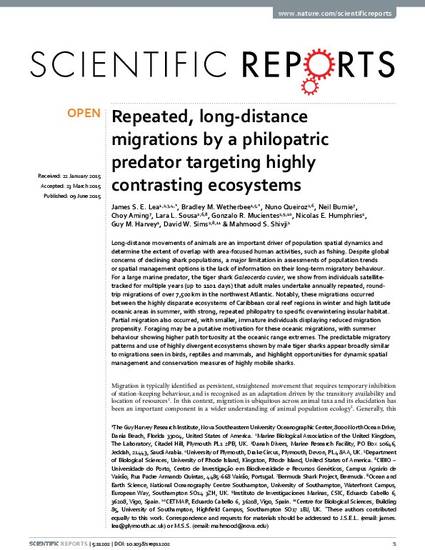
- Animal migration,
- Behavioural ecology,
- Ecosystem ecology
Long-distance movements of animals are an important driver of population spatial dynamics and determine the extent of overlap with area-focused human activities, such as fishing. Despite global concerns of declining shark populations, a major limitation in assessments of population trends or spatial management options is the lack of information on their long-term migratory behaviour. For a large marine predator, the tiger shark Galeocerdo cuvier, we show from individuals satellitetracked for multiple years (up to 1101 days) that adult males undertake annually repeated, roundtrip migrations of over 7,500km in the northwest Atlantic. Notably, these migrations occurred between the highly disparate ecosystems of Caribbean coral reef regions in winter and high latitude oceanic areas in summer, with strong, repeated philopatry to specific overwintering insular habitat. Partial migration also occurred, with smaller, immature individuals displaying reduced migration propensity. Foraging may be a putative motivation for these oceanic migrations, with summer behaviour showing higher path tortuosity at the oceanic range extremes. The predictable migratory patterns and use of highly divergent ecosystems shown by male tiger sharks appear broadly similar to migrations seen in birds, reptiles and mammals, and highlight opportunities for dynamic spatial management and conservation measures of highly mobile sharks.
Available at: http://works.bepress.com/mahmood-shivji/97/

This work is licensed under a Creative Commons Attribution 4.0 International License. The images or other third party material in this article are included in the article’s Creative Commons license, unless indicated otherwise in the credit line; if the material is not included under the Creative Commons license, users will need to obtain permission from the license holder to reproduce the material. To view a copy of this license, visit http://creativecommons.org/licenses/by/4.0/